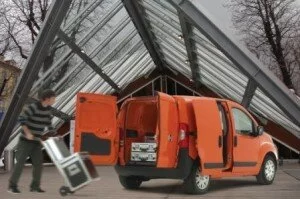
The smallest of the Fiat vans, the Fiat Fiorino’s small size does not limit its multiple capabilities.
Bakkies have traditionally been the vehicle of choice for those moving goods and doing deliveries.
However, many businesses are finding that vans are just more practical, especially in cities.
The sliding door on the left or kerb side, the lower load bay floor, and useful protected space, all make a van more practical than a bakkie with a canopy.
In most cases the air-conditioning in these vehicles is very effective, resulting in ideal vehicles for florists and anybody with temperature-sensitive loads.
Fiat has been the leader in this market segment in Europe for years, having started by building commercial vehicles in 1903.
With the introduction of the Fiat Fiorino, the Fiat Professional range now comprises three model lines including the recently upgraded Doblo Cargo and the much larger Ducato ranges.
“Fiat Professional is a major contender in the European market and has been awarded numerous international prizes by panels of trade journalists,” says Craig Westray, the General Manager of Marketing & Communication at Fiat Group Automobiles South Africa.
Fiat offers two options in the range – the Fiorino and the Doblo.
FIAT FIORINO
The smallest of the Fiat vans is the Fiorino, which offers great benefits in terms of pricing, safety, practicality and versatility. It is an intelligent solution for complex business requirements.
Fiorino is rated to carry just over half a ton and 2.5 m³.
A sliding side-door is available as standard fitment on the 1.3 litre diesel model and as an optional extra on the 1.4 litre petrol model. A second sliding side-door is also available as an option, further adding to the practicality by allowing one to easily access goods in the load bay no matter where they are stowed.
This gives it a distinct advantage over a bakkie fitted with a canopy, where one would not be able to access items loaded first or at the rear of the load bay.
The separation unit between the cab and the load area comes in three versions. A solid metal panel or a metal panel with a window.
If you specify the latter, the rear door also gets a window. The third type of divider is a sturdy pipe structure behind the diver.
This means the passenger seat can be folded down and longer items (up to 2.5 m) can be carried. This is the most popular version in South Africa.
The petrol version is a 1.4 litre with multi-point sequential phased electronic injection. The results are very good performance and fuel consumption figures of a claimed 6.4 litres per 100 km on a combined cycle route. In reality expect around 7.5 litres per 100 km.
The 1.3 litres inter-cooled turbo diesel promises a consumption of 4.6 litres per 100 km on the combined cycle run.
That figure can be reduced to a remarkable 3.9 litres per 100 km on the open road. Expect around 1.5 litres per 100 km for higher consumption in the real world, which is still amazing.
Standard equipment includes hydraulic power-steering, driver and passenger airbags, and ABS brakes with EBD for enhanced safety.
The centre console is equipped with an ashtray, cup holders, a cigarette lighter and a 12-volt socket. There are numerous storage compartments and a roomy glove compartment as well as place for a laptop.
Many other options are also available, including parking sensors, remote central locking, air-conditioning, a car radio with CD player and MP3 compatibility, steering wheel radio controls, and more.
Fairly basic materials are used throughout, but it appears to be well put together.
Service intervals are 12 months or 20 000 km apart for both petrol and diesel derivatives. It comes standard with a three-year or 100 000 km warranty.
The 1.4 litre petrol model costs R129 900 and the 1.3 litre turbo-diesel model costs R149 900.
Optional extras are as follows: a solid partition at R2 500, a partition with glass at R3 000, air-conditioning at R7 500, a sliding door at R3 500, a radio at R2 500, a steering wheel with audio controls at R1 500 and remote central locking at R800.
FIAT DOBLO CARGO
The Fiat Doblo Cargo is available with a choice between three engine derivatives: a
1.4 litre petrol engine and two diesel types, 1.3 litre multijet and 1.6 litre multijet.
The short-wheelbase model can accommodate a 750 kg load on two standard pallets in standard guise, but can be upgraded to accommodate a one ton load while the long-wheelbase version features a one-ton capacity as standard.
Outer dimensions are larger than the previous model:
4 390 mm long, 1832 mm wide, 1 854 mm high and with a wheelbase of 2.755 mm with a loading volume of 3.4 m3.
The Doblo Maxi has an outer length of 4 740 mm, a height of 1.880 mm and the same width as the short-wheelbase and a loading volume of 4.2 m3. The load threshold of 54.5 cm from the ground remains the same as the previous model.
The interior includes a roof shelf, larger and more functional than the one featured in the previous model.
The side-door holders can hold two half-litre bottles of water and an A4-sized folder, while the large glove compartment with lock and key can accommodate a 14-inch laptop.
There is an open compartment above the glove compartment and many other handy compartments for holding objects such as cellphones, pens and coins.
All models in the Doblo range have a standard three-year or 100 000 km warranty and a four-year or 60 000 km service plan.
Prices start at R159 900 for the Doblo Cargo 1.4 litre.
